Pond
Type of resources
Available actions
Topics
Keywords
Contact for the resource
Provided by
Representation types
Update frequencies
status
-

Slope interpreted in terms of suitability of topography for pond construction. Slope data was obtained from the FAO-UNESCO Soil Map of Africa at 1:5 million scale. This dataset includes three slopes classes which reflect the topography in which the soil association occurs.
-
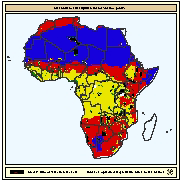
Total amount of water required for fishponds during the dry season. This net annual water requirement was computed using a water budget equation for each grid cell. The equation is based on the difference amongst precipitation, potential evapotranspiration and seepage and these calculations were derived from monthly evaluations. Mean monthly gridded values for precipitation were obtained from the Centre for Resource and Environmental Studies (CRES) at the Australian National University. GRID files containing monthly potential evapotranspiration values according to Penman-Monteith method for the whole world were obtained from the International Institute for Applied Systems Analysis (IIASA). Seepage was a coefficient in the water budget equation.
-
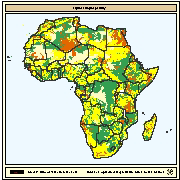
Engineering capability for pond construction obtained by combining soil texture and slope. Soil texture was interpreted in terms of suitability for pond construction. Soil texture data was obtained from the FAO-UNESCO Soil Map of Africa at 1:5 million scale. This dataset includes three soil texture classes: coarse, medium and fine and these are given for the dominant soils of each association and refer only to the upper 30cm. Slope was interpreted in terms of suitability of topography for pond construction. Slope data was also obtained from the FAO-UNESCO Soil Map of Africa at 1:5 million scale. This dataset includes three slopes classes which reflect the topography in which the soil association occurs.
-
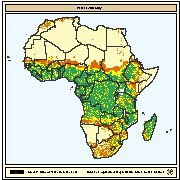
Spatial distribution of water availability for fish ponds. Map derived from the combined suitability of annual rainfall with density of perennial streams and rivers. Annual rainfall interpreted as rainfall runoff to fill fishponds. Mean annual precipitation data for Africa were obtained from UNEP/GRID in Nairobi and was developed for the Global Assessment of Soil Degradation (GLASOD) using data from 1951-1980. A digital map of perennial streams and rivers was generated by ESRI (1984).
-

Montly water requirement for fish ponds during the dry season. Water requirement was computed using a water budget equation for each grid cell. The equation is based on the difference amongst precipitation, potential evapotranspiration and seepage. Mean monthly gridded values for precipitation were obtained from the Centre for Resource and Environmental Studies (CRES) at the Australian National University. GRID files containing monthly potential evapotranspiration values according to Penman-Monteith method for the whole world were obtained from the International Institute for Applied Systems Analysis (IIASA). Seepage was a coefficient in the water budget equation.
-
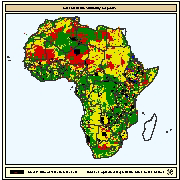
Suitable areas for the construction of fishponds based on the combined suitability of soils and slopes. Soils evaluation was based on FAO's Digital Soil Map of the World (DSMW) and included: texture, effective soil depth, pH, salinity, and the presence of catclays and gypsum. Slope was derived from a global digital elevation model (GTOPOP30) in the form of percentages. To consider the combined suitability of soils and slopes, it was considered that the former were more important than the latter. This was because suitable soils would ensure two of the most important engineering capability factors for pond construction: good water retention and good pond fertility
-
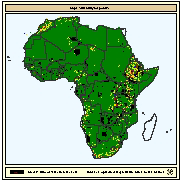
Suitable areas for the construction of fish ponds based on a slope evaluation. Slope was derived from a global digital elevation model (GTOPOP30) in the form of percentages.
-
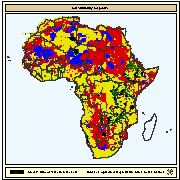
Suitable areas for the construction of fish ponds based on a soils evaluation. Soils evaluation was based on FAO's Digital Soil Map of the World (DSMW) and included: texture, effective soil depth, pH, salinity, and the presence of catclays and gypsum.
-

Soil texture interpreted in terms of suitability for pond construction. Soil texture data was obtained from the FAO-UNESCO Soil Map of Africa at 1:5 million scale. This dataset includes three soil texture classes: coarse, medium and fine and these are given for the dominant soils of each association and refer only to the upper 30cm.
-

Suitable areas for the construction of fish ponds based on the suitability of soils characteristics. FAO's Digital Soil Map of the World (DSMW) was used to derive the soil and terrain suitability for fish ponds.
 FAO Map Catalog
FAO Map Catalog